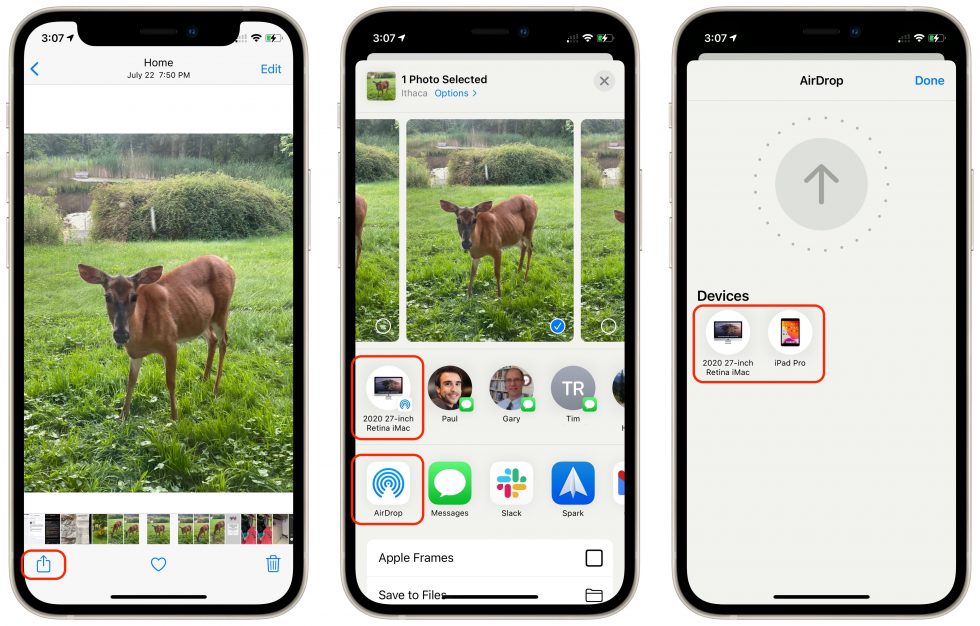It’s common to want to share files, photos and other data between your devices—or with friends and family. When the person or device isn’t nearby, it’s easiest to use Messages or Mail. But if you want to move a file between two of your Macs, from your iPhone to your Mac or to your friend who’s across the table, you can use AirDrop. This is a quick and easy way to move data between devices.
Make Sure AirDrop Is Ready to Go
AirDrop requires both Wi-Fi and Bluetooth, so make sure to enable both tools. If you use wired Ethernet on your Mac, enable Wi-Fi as well, but put the Wi-Fi service beneath the Ethernet service. Find this in:
System Preferences > Network
(click the down-pointing arrow under the list and choose Set Service Order).
Next, make sure other devices can discover you.
On the Mac, choose: Go > AirDrop
Near the bottom of the Finder window that appears, choose Everyone from the pop-up menu. (If you’re out in public, choose Contacts Only to prevent random people from connecting with you.)
On an iPhone or iPad, go to:
Settings > General > AirDrop and select Everyone.

Send a File or Photo via AirDrop
Apple integrated AirDrop into the standard sharing mechanism in macOS, iOS and iPadOS. Sharing via AirDrop works the same as sharing via most other apps.
In the Finder on the Mac, select AirDrop in a Finder window’s sidebar. Then drag files to the icon representing the destination device (see image below/left). You can also select one or more files and choose:
File > Share > AirDrop or Control-click them and choose Share > AirDrop, both of which present a dialog from which you can select the destination (below right).
The right-hand dialog is also what you’ll see if you use the Share option in Photos or any other app.

On an iPhone or iPad, when you’re viewing the item you want to share, tap the Share button to bring up the Share sheet. You may be able to tap the AirDrop icon for the desired destination directly in the top row. If it doesn’t show what you want, tap the general AirDrop icon in the second row. This will display the AirDrop screen with icons for all available destinations. Either way, tap the destination to send the file.

Receive Data via AirDrop
On the receiving side, AirDrop is simple, particularly when your transfer files between your devices.
- Receiving on a Mac: If you’re transferring between your own devices, you don’t need to do anything; the file will appear in the Downloads folder of the destination Mac. Files other people send will appear there too, but you’ll get a prompt asking you to accept or decline the file. If you accept, you’ll see an option to open it in the appropriate app.

- Receiving on an iPhone/iPad: Receiving on an iPhone or iPad is similar, with one additional step. Unless iOS/iPadOS knows where the file should go (images always import into Photos automatically, for instance), it prompts you with a list of apps that can open the file. It automatically accepts files you transfer between your own devices. For files from other people, you must tap the Accept button first.

Troubleshooting AirDrop
AirDrop has been around since 2011. Apple made significant updates since then. If you had trouble getting AirDrop to work years ago, it’s worth trying again. That said, problems can still crop up:
- If a Mac doesn’t appear as an AirDrop destination, make sure it has Wi-Fi active. Ethernet is not sufficient. Also, if the Mac’s firewall is active, check that it allows incoming connections.
- Open System Preferences > Security & Privacy > Firewall > Firewall Options and deselect “Block all incoming connections.”
- If an iPhone doesn’t appear as an AirDrop destination, make sure Personal Hotspot is turned off in Settings > Personal Hotspot.
- AirDrop relies on Bluetooth and Wi-Fi. Interference with either, or a separation between devices of more than 30 feet (9 meters), can cause performance and reliability to suffer.
- For best results, make sure you’re using recent Apple hardware running the latest versions of macOS, iOS and iPadOS. Technically, AirDrop requires a Mac introduced in 2012 (excluding the 2012 Mac Pro) or later running OS X 10.10 Yosemite or later. On the mobile device side, the iPhone, iPad or iPod touch must run at least iOS 7.
- If AirDrop prompts you to accept transfers between your own devices, that’s an indication that the devices aren’t logged in to the same iCloud account.
- Although AirDrop has no explicit size limit, very large files (over 500 MB) will take a long time to transfer and are more likely to fail due to network issues during the transfer.
- If you can’t find a transferred file in the destination Mac’s Downloads folder, remember that it retains its original creation and modification dates, so it might sort differently than you expect.
Next time you need to move data between nearby Apple devices, give AirDrop a try!
Proof of Vaccination
With some employers and some transportation services requiring proof of vaccination, you may be looking for an option to verify and store your proof of vaccination. VaxYes makes it easy to store this information in your iPhone wallet app. Their materials explain, “In 3 easy steps you can get a secure, digital vaccine record that you can use for travel, live shows, and employers.” This may be the perfect way
About arobasegroup
arobasegroup has been consulting with clients and advising the best use of Apple Technology since 1998. We listen to our customers and solve problems by addressing their specific, unique needs; we never rely on a one-size-fits-all solution or require them to use a specific product. arobasegroup is your advocate in all things related to information technology. Contact us to learn how we can help: info@arobasegroup.com.
Keep Up-to-Date: An Invitation
Keep on top of all the latest Apple-related news via our social media feed. When you follow us on our social media channels, you will always be up-to-date with the most relevant Apple news and have easy access to tips and useful articles relevant for Apple, iPhone, iPad and Apple Watch users. You won’t want to miss these articles and suggestions. Please follow arobasegroup on LinkedIn by tapping here. Thank you!





